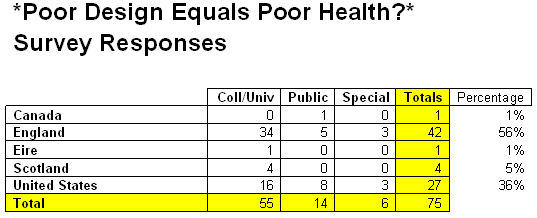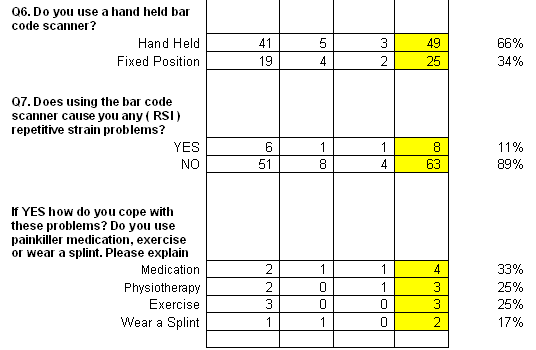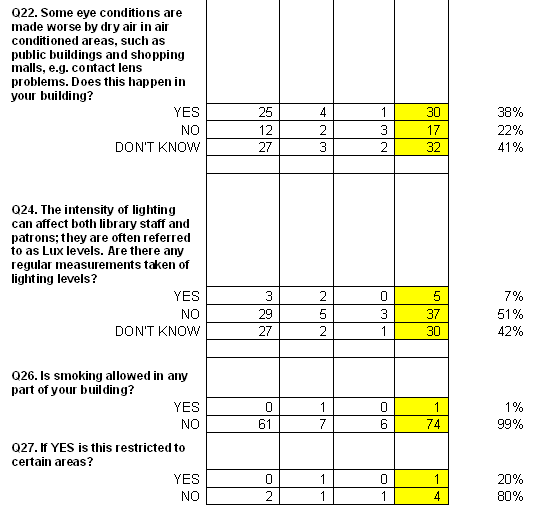





ASSOCIATES (2006, July, v. 13, no. 1) - associates.ucr.edu
Poor Design Equals Poor Health?
Questionnaire - The Final Results
by
Jim Jackson, Law Library University of Exeter
In November 2005 the ‘Poor Design Equals Poor Health’ questionnaire was launched in ‘Associates: The Electronic Library Support Staff Journal’ (http://associates.ucr.edu) to try and obtain first hand knowledge from front line library staff about the effects of the buildings they worked in. There was anecdotal evidence to support this idea but little modern research to support it.
The survey has now closed and work has progressed on the responses submitted. Replies were received from Canada, USA, Eire, Scotland and England, from college/universities, public and special libraries. The heading of special libraries includes government libraries as well as school libraries. The survey looked at basic functionality of issue/circulation desks and overall building suitability for the purpose, and the responses to complaints made by staff to working conditions.
The results showed that 69% of issue desk staff had to stretch across a desk with 40% saying that this caused regular muscle pain. The most common areas for this pain were 38% shoulder, and 35% back, with a further 12% registering wrist pain. One of the possible causes for this is the basic design of the desk: 77% work on a flat surface, with only 23% working with a raised workstation. A common complaint was that the raised shelf added to the lifting stress levels. This was particularly noted in academic libraries, which often have a constant flow of library users.
The use of handheld as opposed to fixed position barcode scanners did raise the problem of RSI (repetitive stress injuries), with 11% of library staff reporting that they considered it contributed to RSI problems in their wrists. While this may not seem a large percentage the added worry is that 39% reported that they received no regular training in manual handling, and those that did often had ergonomic reports either rejected by their employers or put on future development plans. With a large concentration of IT in libraries these days a large number of staff reported a worrying amount of wrist problems and ‘trigger finger’ medical problems with the constant use of a computer mouse. This can best be defined in medical terms as stenosing tenosynovitis, which is a "snapping" of any of the digits of the hand when opened or closed. Typically, trigger finger is noted when either the ring, middle, or index finger attempts to flex closed while gripping. Instead of a smooth, continual closure, the digit stutters, then snaps closed. The closure is frequently associated with pain at the base of the digit on the palm of the hand. Trigger finger can also affect the thumb.
The survey asked how they dealt with IT-related health problems: 33% used some form of regular medication, 25% had physiotherapy, 25% used special exercises, and 17% had to use a surgical splint. Some staff were allowed to alter shift patterns, so that they did not spend all day working on front services, and this helped apart from the continued use of IT equipment, heavy lifting in connection with shelving. But it does appear that some staff are employed specifically to work on issue/circulation desks who then have little option to work elsewhere.
A large 75% of respondents reported that they worked in air-conditioned buildings, with 67% then saying that there were regular on-going problems with their buildings. Of these, 9% had then reached the stage for drastic changes following the confirmation of sick building syndrome. One of the most common complaints, apart from lack of temperature control, was the dryness of air inside buildings: 38% said that they had personal problems with the dry air affecting their use of contact lenses, and the high occurrence of headaches.
Previously the amount of light in buildings has not been a factor that has been considered important, as many buildings had natural light and additional electric lighting. Many buildings now require electric light as the main source of lighting and very little or even no natural light is available in some areas. In recent times this lighting problem has been recognised. Lux levels can now be measured, modern light tubes can give off ‘natural’ light, and this improves the working conditions. These newer light tubes are often more expensive and may have implications for building maintenance costs, which are beyond the control of library managers. The survey reported that only 7% of buildings had regular Lux levels taken which were reported to library staff and action taken, while 51% said they received no reports and 42% said they did not know if any light readings were ever taken.
One positive step that has been taken, and was generally welcomed, was that all libraries were reported to be no smoking zones. Even in libraries that were based in combined units with other services in the institution, or with public services. An added problem is that many reported problems with smokers gathering outside the main entrances, making entering and exiting the building unpleasant. This also caused air conditioning units to suck up this smoke into the building in some cases, which was circulated within the building, defeating the object of having a smoke free environment.






The results from the survey clearly show that there are some basic questions which need to be asked before installing a new issue/circulation desk. Firstly – how busy is the area likely to be, on a regular basis, what transactions take place there and how many people will work in the area. Then If it’s a busy academic library or public library staff are likely to stand for long periods, rather than sit. Therefore having a raised shelf in front of them and the user, will explain the high number of complaints the survey received about raised desks as opposed to flat ones because of the extra lifting and stretching required. Equally if the issue desk is used as part of an enquiry desk with a slower flow of people a lower desk is clearly desirable. See Question 1 below for sizes of various desks.


Air conditioning is clearly a major cause of concern for those who work in building which have it. While there are those few, only 33%, who have no problems with their systems, this does leave a massive 67% who do have problems. There is a clear ‘hit list’ of common complaints with lack of temperature control as the most contentious issue. This ranges from buildings being very hot and stuffy, with regular temperatures of 30 degrees Centigrade. To other extremes where people complain of freezing cold temperatures in some parts of a building and very hot in other parts of the same building.
The second really big problem is that of air circulation, in some cases the systems are designed to work in big open plan buildings, but the introduction of book stacks disrupts the air flow. Humidity is a similar story with wildly varying extremes, in some cases causing build up of mould, and people having dry eyes. This in turn effects the wearing of contact lenses.
Thirdly the vents themselves are often not cleaned very often, and can blow a steady stream of dust and other debris over library staff and stock. This can over time block the vents. A health hazard rarely dealt with, which many library staff felt was often ignored.
Thanks to Lydia Collins, California State University, Stanislaus, for her help with the initial survey work and to Wendee Eyler, Editor of 'Associates: The Electronic Library Support Staff Journal' is gratefully acknowledged in the production of this survey and its results.
The moral and intellectual property rights of the author have been asserted by Jim Jackson / University of Exeter